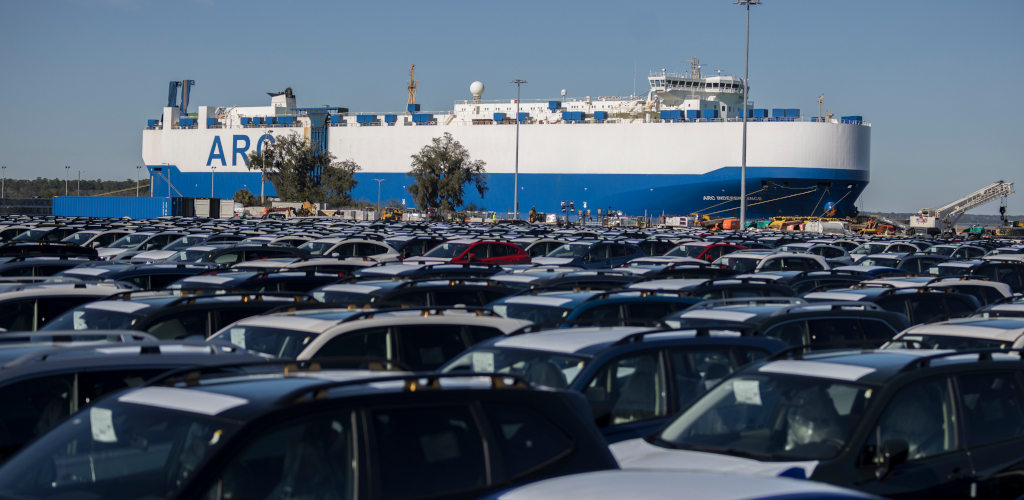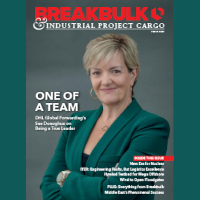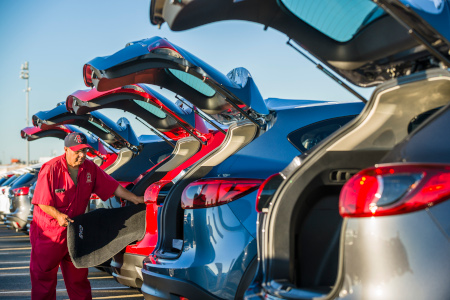Biting Point for Breakbulk Car Sales

By Lori Musser
 A few short years ago, the U.S. was the global leader in electric vehicle exports. Early volumes were small and supply chain participants were able to accommodate the volumes with a few adjustments to services and operations here and there.
A few short years ago, the U.S. was the global leader in electric vehicle exports. Early volumes were small and supply chain participants were able to accommodate the volumes with a few adjustments to services and operations here and there.
Now, a new, much larger American EV export wave may be forming. Breakbulk carriers, ports and terminals are eagerly awaiting.
The demand for EVs is being pushed and pulled. As the world cries out for decarbonization, consumers are choosing hybrids and EVs. Internal combustion engines, or ICEs, are becoming persona non grata and governments are increasing support for electrified vehicles.
Early adopters located throughout Europe, Canada and along the U.S. West Coast will eliminate new ICE vehicle sales in a few short years. The International Council on Clean Transportation reports some of the targets for phasing out sales of new ICE cars begin as early as 2025.
Of course, EV adoption will rise as prices fall; technological advancements have shrunk EV battery costs. The U.S. Department of Energy, or DoE, recently reported that, based on 2022-constant dollars, lithium-ion battery pack costs fell to an average of US$153/kwh of usable energy (given a 100,000-unit+ annual production volume). That number is down from more than US$1,300 in 2008.
US MOMENTUM
When the Biden administration’s momentous EV incentives begin to bear fruit, a U.S. production surge can be expected. There are three big government drivers.
The first is the Department of Commerce’s CHIPS and Science Act. The U.S. plans to address the global shortage of semiconductor chips by revitalizing production at home, starting with US$39 billion in semiconductor incentives. The Act’s first funding opportunity was announced on March 1, 2023.
 The second is a basket of automotive manufacturing gifts from last year’s Inflation Reduction Act. They include provisions for the EV production supply chain, buyers and infrastructure. The third pot of money comes from the Bipartisan Infrastructure Law, set to trigger investment in a national EV charging network, and mineral and raw materials supply for battery makers.
The second is a basket of automotive manufacturing gifts from last year’s Inflation Reduction Act. They include provisions for the EV production supply chain, buyers and infrastructure. The third pot of money comes from the Bipartisan Infrastructure Law, set to trigger investment in a national EV charging network, and mineral and raw materials supply for battery makers.
Combined, these provisions will undoubtedly expand vehicle electrification in the U.S.
In a statement, John Bozzella, president and CEO of the Alliance for Automotive Innovation, said: “The Inflation Reduction Act recognizes the enormity of the automotive industrial base transformation currently underway. Automakers have already invested more than US$100 billion in vehicle electrification – expanding the production of EVs … and locating raw material and battery components on American soil.” He added: “There is more than US$15.5 billion in incentives and grants to ensure the United States is building automotive supply chains and a globally competitive battery manufacturing platform.”
BREAKBULK CARRIERS GET READY
While there is no telling if or when U.S. EV production capacity will produce strong exports, auto carriers are preparing.
Bryan McCausland is senior manager of sales (auto – U.S.) for leading roll-on, roll-off and vehicle logistics provider Wallenius Wilhelmsen. Speaking to Breakbulk, he acknowledged that incentives, regulations, infrastructure and improved consumer confidence all drive increased EV sales and exports.
He said: “We are equipping terminals and port processing facilities around the world with sufficient EV charging infrastructure … to help vehicles flow through the supply chain without disruptions.”
This can’t be done single-handedly. “We are working with OEMs and industry forums to ensure that the marine transport of EVs is completed with safety as the number one priority,” McCausland said.
Wallenius Wilhelmsen’s first EV shipment took place in 2000, so the company has long experience. Operationally, EVs have a few idiosyncrasies. Some best practices in handling include double lashing EVs for safe storage on vessels, having plenty of charging units available throughout a global transit (batteries can lose power when the car isn’t moving), and exercising additional safety precautions (such as sounding horns when cars are started) because EVs are almost silent.
Erik Solum leads global market insights for Wallenius Wilhelmsen. Solum is cautiously optimistic for the roll-on, roll-off industry in general. In his outlook for 2023, he said there is still pent-up demand for light vehicles, and the high and heavy segment should remain solid, but there is a long list of challenges facing the industry.
Vessel capacity has been tight and will remain so with only 11 vessels on the orderbook for delivery in 2023 to supplement the global fleet of 600 larger roll-on, roll-off vessels.
Solum said: “Even as there are more risks and unknowns than we have ever seen, we are cautiously optimistic when we enter 2023 … We hope for peaceful solutions for the geopolitical tensions and believe the green shift will contribute to accelerated vehicle sales.”
Solum confirmed that Wallenius Wilhelmsen does “expect growth of EVs out of North America.”
HURDLES FOR US EXPORTS
Louis Yiakoumi, auto industry specialist at LConnect, outlined some of the geopolitical issues that impact export vehicle movements. They range from carmaker geographical strategies to a lack of popularity of larger U.S.- sized vehicles in certain markets, to partnerships between automakers that foster local production, eliminating the need for U.S. exports.
These same concerns will likely apply for U.S. EV exports. Americanmade EVs will be up against some strong competition from, for example, China’s carmakers, who may have price advantages, and German carmakers, who are investing rapidly and heavily in EV production with tight regulatory timelines. And the jury is still out as to whether U.S. startup automakers will have the wherewithal to grow globally.
Yiakoumi recognized Tesla as the global EV leader, but noted that Tesla’s new plant in Germany and its Chinese production will offset some of its need to export from the U.S. Overall, he said: “There will be some exports from the U.S., but [likely] less than hoped.”
While the size of the future U.S. EV export market is uncertain, the auto business is massive and EV parts and finished inventory movements will continue to be bread and butter for many carriers, ports and terminals/ processors. They are putting strategies in place.
 Cliff Pyron is chief commercial officer for Georgia Ports Authority, or GPA. Pyron said to Breakbulk: “There’s no question that major investment is already underway throughout the region to support EV manufacturing growth. What’s occurring now is transformational, not only for Savannah, and Georgia, but also the Southeast.”
Cliff Pyron is chief commercial officer for Georgia Ports Authority, or GPA. Pyron said to Breakbulk: “There’s no question that major investment is already underway throughout the region to support EV manufacturing growth. What’s occurring now is transformational, not only for Savannah, and Georgia, but also the Southeast.”
Pyron added: “With so much investment underway, it’s an exciting time … Since the announcement of the new Hyundai plant, we have also had a fourth announcement for a major OEM supplier which will bring more volumes through the port once those facilities are operational.”
In the next two years, Georgia Ports Authority anticipates a surge of freight and cargo associated with construction of the production sites and assembly at the plants. “We should begin to see an influx of products toward the end of 2023. We will eventually see the various automotive parts coming through in 2025 as the Hyundai plant and its suppliers begin production.”
GPA’s capital investment program creates new capacity and connectivity for general cargo, including roll-on, roll-off cargo. “This year alone, the GPA is investing US$1.8 billion at our Garden City Terminal, Ocean Terminal and the Port of Brunswick. These improvements include expanded berths, the largest ship-to-shore cranes on the Eastern Seaboard, and more space for containerized cargo and roll-on, roll-off processing,” Pyron said.
Auto capacity improvements are underway at GPA’s Port of Brunswick that will increase its roll-on/roll-off capacity to 1.41 million vehicles per year.
Rail is also being expanded. “GPA’s new Mason Mega Rail allows us to reach out to the Southeast … where there is also tremendous investment in automotive production. Our focus continues to be delivering more capacity, faster connections, and greater reach to support the exciting growth in production already underway,” Pyron said.
MOVEMENT OUT WEST
While a great deal of EV plant capacity is being built in the U.S. Midwest and Southeast, supply chains to the west are also watching the industry closely. A Port of Portland spokesperson told Breakbulk that the port is currently discussing electrification as part of its long-term strategic plan, but that there haven’t been major operational changes for EVs at marine terminals, yet.
“We have assessed the need for charging infrastructure terminal-wide and in conjunction with expanding auto imports and exports,” the spokesperson said.
There may be some “hurry up and wait” necessary across import-export supply chains, as technology develops as it is not yet crystal-clear which charging approaches will emerge as best practice for distribution facilities.
Nevertheless, “electrical service requirements will be significantly greater … it is likely that new or upgraded electrical services will be required,” she said, adding: “We are laying the groundwork for providing locations and charging capabilities as they are identified by our vehicle processor.”
Alex Munro, senior communications advisor for Canada’s Port of Vancouver, described a slightly different business case for U.S./North American-made EVs.
He said: “Currently, auto volumes through the Port of Vancouver are all imports to service the local market, with about 94 percent arriving on ships from overseas and 6 percent arriving via rail and truck from North America. Auto terminals at the Port of Vancouver are strategically positioned to handle inbound Asian-manufactured vehicles arriving on ships to serve Canadian demand.”
That may not change overnight. Munro said it is a simple case of demand economics.
“The potential for Port of Vancouver auto terminals to handle electric vehicle exports in the future depends on both North American production and demand, and overseas production and demand,” Munro said to Breakbulk.
“While production of electric vehicles is set to accelerate in North America, it is also expected to accelerate in Asia. Our expectations are that the existing import-export dynamic at Port of Vancouver, as well as at U.S. West Coast auto ports, will continue to remain in place for some time,” he added.
TERMINAL OPERATORS GEAR UP
AMPORTS, a port terminal operator and automotive services company with operations in the U.S. and Mexico, has seven U.S. facilities spanning the west, gulf and east coasts.
Tomasz Lis is AMPORTS’ vice president of business development. He said that because the wide range of government incentives will bring more EV manufacturing and battery production to the U.S., auto imports may be impacted somewhat. “Locally sourced models would become more economically attractive for the buyers, replacing some of the imports,” Lis said.
But ports and terminals will still handle EV imports, as well as a continuing two-way trade in combustion engine vehicles, at least for the next decade or so. And new volumes of EV exports are anticipated too.
As EV production increases, and high volumes of finished vehicles begin to roll out of U.S. plants, Lis said it will be important for port-based automotive processing facilities to be prepared for longer dwell times. Processors may need to invest in “software upgrades and expanded battery maintenance services,” among other provisions. Lis expects processors’ strategic model mixing and distribution services will prove very important to EV automakers.
AMPORTS has already been scaling its EV charging infrastructure according to the requirements of customers. And, “upgrades to the electrical grid may be required depending on the surge in demand for charging services. Also, I would see more focus from the OEMs going forward on being able to provide clean energy to the EV vehicles,” Lis said.
One of the conundrums of America’s all-in for EV policies is that, while EVs produce no tailpipe emissions, charging them can result in power plant emissions. Supply chain participants – from motor carriers to ports and terminals and even ocean carriers – now have to think about the sources of their electricity.
But, all told, the writing is certainly on the wall. ICE vehicles are in decline and EV vehicles are the darling of governments, environmentalists and the purchasing public. The U.S. has put a massive amount of money behind expanding its EV industry, and production will ramp up shortly. Supply chains are standing by to accommodate EVs, with capacity and a few tweaks to operations in hand.
It is not yet known whether the U.S. production build up will lead to mass exports, but even a small percentage of exports is important given the size of the world’s car markets.
Based in the U.S., Lori Musser is a veteran shipping industry writer.
IMAGES:
TOP: RoRo operations at GPA’s Port of Brunswick. CREDIT: Steve Morton
SECOND: EV inspections. CREDIT: Pasha Group
